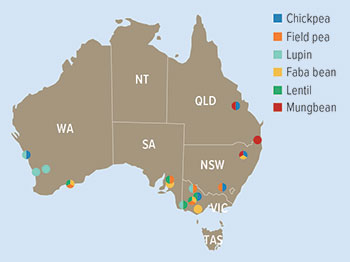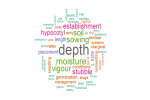When it comes to Australian-grown pulses, one market dominates pulse production – the export market for unprocessed grain.
 Cultivars grown at Narrabri during the 2024 pulse diversification trials: mungbeans (top), chickpeas (middle) and faba beans (bottom). Photos: Nicole Dron, NSW DPIRD
Cultivars grown at Narrabri during the 2024 pulse diversification trials: mungbeans (top), chickpeas (middle) and faba beans (bottom). Photos: Nicole Dron, NSW DPIRD
Only a few alternatives exist to process the grain within Australia and exploit the nutritional properties of pulses for food manufacturing.
A $13.6 million project started in 2024 to create the foundations needed to develop more diverse end-use markets for six pulses – lentils, chickpeas, field peas, faba beans, mungbeans and lupins.
GRDC is contributing $8.8 million to the work, a co-investment with Agriculture Victoria.
Leading the team at Agriculture Victoria is Dr Cassandra Walker, who says that at its core, the project aims to generate the foundational data needed by growers, breeders and food manufacturers to expand market demand and end-uses.
“There are two key and intertwined issues we need to tackle before market diversification can become a reality,” Dr Walker says.
“We need to understand the nutritional composition of our pulse grains, including their functional properties in food manufacturing.”
This amounts to understanding the pulse equivalent of the impact on dough of different wheats, she says.
For pulses, this includes properties such as water and oil holding capacity.
“We also need to understand how the profiled characteristics vary as a result of being grown in different environments and seasons.
“That is why we need both chemistry and agronomy experts on the project team.”
Profiling Australian pulses
Understanding the nutritional composition of pulses entails profiling key chemical nutrient groups. Especially targeted is the grain’s protein content, right down to its amino acid profile. But it also includes oils, fatty acids, starch and fibre.
This data is generated using non-destructive spectroscopic methods, such as infrared and nuclear magnetic resonance technology that can identify the chemical make-up of compounds.
With regards to functional properties, there is a need to understand what food manufacturers are looking for and how pulses can fit into these requirements.
This aspect of the project is targeting primarily human food products and applications that increase the nutritional value of diets and create a wider range of consumer options.
“As things stand, little is known on the nutritional composition of the pulses we grow and what they can be manufactured into,” Dr Walker says.
That's the knowledge gap we want to close.
Getting at that data, however, is not as simple as putting grain samples through a chemical analysis pipeline and deriving some average figures.
Dr Walker emphasises that this will not cut it since food manufacturers have a core requirement regarding the whole foods they process: “When it comes to the key nutritional and functional properties, they need consistency.”
This is true already for growers who provide grain for dough, pasta and brewing applications. It also needs to become true for pulse growers if new, value-add markets are to be created.
Consistency field trials
What this all adds up to is a need for field trials across the nation on a scale that encompasses both the major and more marginal (or expansion) growing regions for the six pulses.
On top of that, these trials need to be undertaken on a vast scale since they need to incorporate all the commercially available cultivars for the six pulses.
Figure 1: Field trial sites that are producing data needed to help diversify end-use markets for six pulses.

Source: Agriculture Victoria
Each pulse type is being grown at five sites – three that are representative of the major national growing regions in Victoria and New South Wales and two more marginal areas or expansion zones.
The only exception is mungbeans, which is limited to three sites.
The trials will run over two seasons to generate data on protein content and how it varies across sites and seasons.
In addition, the project has also assembled diversity sets containing germplasm housed at the Australian Grains Genebank (AGG). These will be processed in field trials with the aim of understanding the maximum possible genetic variation available within the broader gene pool for nutritional traits.
A set of about 250 accessions has been assembled for this purpose for each of the six pulses.
This data then becomes useful for breeding, should the need arise to tinker with a cultivar’s nutritional traits or the genetic basis of that trait (and, therefore, the consistency of trait expression).
“While previous studies have attempted to understand gene-by-environment effects in pulses, this is the first time we are doing it systematically at this scale and with regards to grain quality traits,” Dr Walker says.
The goal is to process all released varieties in replicated trials so that they are comparable.
Trials were conducted during 2024 for the released varieties at 15 sites (Figure 1).
The trials were designed to allow the plots to experience seasonal stresses rather than being grown under optimal conditions. However, trial managers did irrigate and spray as needed to avoid crop failure. The first trial of the diversity sets is being rolled out in 2025.
Implications
Pulses are rapidly becoming a cornerstone for achieving several desirable outcomes.
They allow for more sustainable and profitable farming systems. They reduce the need for nitrogen fertiliser, thereby reducing environmental impacts.
Pulses are also known to benefit human health. They are a nutritionally dense grain that is a good source of protein, carbohydrate and fibre that is low in fat and has a low glycaemic index.
These benefits have resulted in a rapidly expanding global market for plant-based protein. Demand has been forecast to surpass $250 billion globally by 2035.
As things stand, however, Australia is not on track to tap into this market.
Australia exports on average 2.5 million tonnes of pulses a year. That makes Australia the world’s second largest pulse exporter.
More than 90 per cent of pulses are exported as whole unprocessed grain. Market demand is strong. For example, Victorian lentils alone generated $638 million in export income in 2022-23.
The Agriculture Victoria project stands to open the way to capture value from greater levels of onshore processing of pulses.
The aim is to attract higher premiums for growers, provide a diversity of markets and maintain Australia’s competitiveness.

Dr Cassandra Walker (second from right) with team members Linda McDonald (left), Dr Audrey Delahunty (second from left) and Dr Pankaj Maharjan (right). Photo: Kerrie Flett (AVR)
Partnerships
To work at this project’s scale meant establishing a large network of collaborating partners.
A key collaborator is the Analytics for the Australian Grains Industry, which assisted with the design of trials to ensure the project can produce statistically significant datasets. It is also assisting in processing and analysing trial data.
Collaborators include NSW DPIRD, the Commonwealth Department of Agriculture and Fisheries (DAF), University of Adelaide, South Australian Research and Development Institute, Living Farms, Birchip Cropping Group, Josh Bell Ag, Australian Grain Technologies, Southern Farming Systems, Frontier Farming Systems, University of Melbourne, La Trobe University, IMPROVE, the International Center for Agricultural Research in the Dry Areas, the Grains and Legumes Nutrition Council, Food Frontier, Grains Australia, Harvest B, Essantis, Kraft Heinz, V2 Foods, Mauri, Grain Corp, Integra, Wide Open Agriculture, Waltanna Farms, Clextral, Australia Pulse Council and Roquette.
Agriculture Victoria research project team
Dr Cassandra Walker – research leader, crop quality (project lead); Dr Audrey Delahunty – senior research scientist, crop agronomy; Dr Linda McDonald – data analyst, crop quality; Dr Pankaj Mahajan – research scientist, crop quality; Ms Penny Rifkin – senior research scientist, crop agronomy; Mr Nicholas Rigas – research scientist, crop quality; and Ms Kerrie Flett – research scientist, crop quality.
More information: Cassandra Walker, cassandra.walker@agriculture.vic.gov.au
Resources: Read GroundCover Supplement story Lentil breeding on turbocharge.

























































